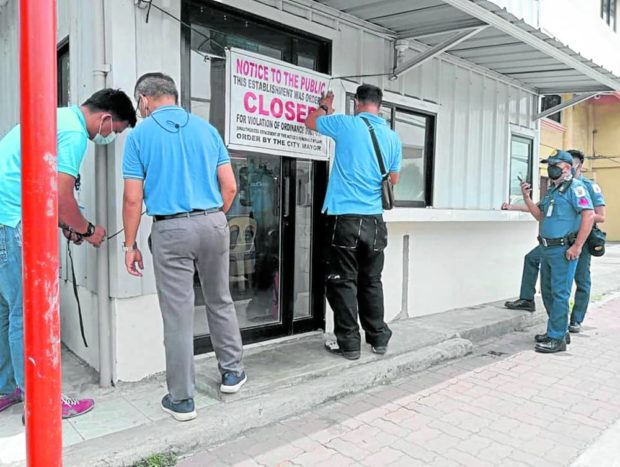Iloilo City in state of calamity amid surge in cholera, gastro cases

SELLING DIRTY WATER | Personnel of the Iloilo city government’s Investment Services Business Permit and License Division closed at least 26 water refilling stations last week after water samples from these establishments were found positive for coliform and E. coli in lab tests. (Photo courtesy of the Iloilo City Investment Services Business Permit and License Division)
ILOILO CITY, Iloilo, Philippines — A state of calamity was declared in this city on Friday amid an alarming surge of acute gastroenteritis and cholera cases believed to have been caused by contaminated drinking water.
The declaration by the city government was prompted by a revelation before the city council by Dr. Annabel Tang, chief of the City Health Office (CHO), that the office had no budget to urgently control the rise in acute gastroenteritis and cholera in the city since no funds were allocated for water- or food-borne diseases, as these had not been recorded in the city in the last three to five years.
The city council, on the recommendation of the Iloilo City Disaster Risk Reduction and Management Council, decided that declaring a state of calamity would be the best option so they could access the city’s quick response fund (QRF) to purchase medicines and other supplies for three months.
Since August up to Sept. 1, the CHO has logged at least 282 acute gastroenteritis and eight cholera cases. At least seven people have also died of acute gastroenteritis in the city since last month, it added.
According to Tang, the uptick in gastroenteritis and cholera cases may have been caused by broken water pipes, the torrential rains and flooding experienced in the city in the last few months, and the shallow level of deep wells.
Article continues after this advertisementTang, appearing during the city council session on Friday, said they tested shallow deep wells and containers used in collecting water from communal pumps and these were found to have traces of E. coli, or Escherichia coli bacteria, and coliform.
Article continues after this advertisementWater refilling stations too
At least 26 water refilling stations in the city were also closed amid the rise in acute gastroenteritis and cholera. These included 14 stations that were found to have coliform in their water and four others that were found selling drinking water positive for coliform and E. coli.
The city’s water provider, Metro Pacific Iloilo Water (MPIW), meanwhile, assured the public that the water they distributed is clean and safe.
“Since last week and when the first few cases of cholera were reported, we proactively conducted 18 bacteriological tests in the affected communities within our business areas. All results showed that our water supply did not have any bacteriological contamination,” said MPIW in a statement posted on its Facebook page on Friday.
MPIW said they have been coordinating with the city government to help prevent the spread of the disease.
Based on the number of cases per district, Iloilo City Proper had the most number of acute gastroenteritis cases at 90, followed by Molo (65), Jaro (40), Arevalo (36), Mandurriao (21), Lapuz (17) and La Paz (13), the CHO said.
Iloilo City Proper also had the highest number of cholera cases at five, followed by Molo (2) and La Paz (1).
People who suffer from acute gastroenteritis would experience nausea, vomiting, diarrhea and abdominal pain.
Unforeseen
The city government agreed to release P12 million of its QRF to the CHO, P5 million of which for the hiring of additional medical personnel, P3 million for medicines, P3 million for medical supplies, P500,000 for fuel, and P1 million for other maintenance and operating expenses.
Tang told the city council that P12 million was needed because their inventory of medicines and supplies were not enough since the rise in acute gastroenteritis and cholera incidents was “unforeseen.”
Tang said P12 million might not even be enough to combat the diseases if the surge could not be contained soon. But she was hopeful that the CHO, in partnership with other government offices and the private sector, would be able to contain the spread of the bacteria.
—JOEY MARZAN
RELATED STORIES
In China’s Wuhan, cholera-causing bacteria in turtles strikes nerve
COVID-19 resurgence, cholera outbreak in Nepal pose ‘increasing challenge’ to public health